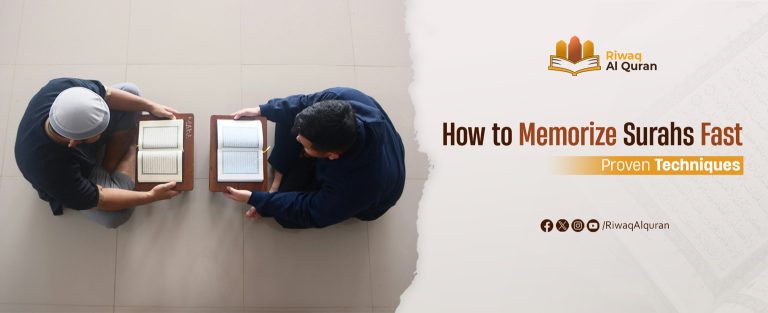Tajweed symbols serve as visual aids to guide reciters in applying its rules accurately. These symbols, such as those indicating vowel elongation (Madd), sound transitions (Iqlab), and sound bouncing (Qalqalah), help preserve the beauty and precision of the Quran’s recitation.
Tajweed is the art and science of reciting the Quran properly. It encompasses the rules that ensure the Quran is read accurately, beautifully, and in accordance with the Prophet Muhammad’s (peace be upon him) guidance. To help with this, Tajweed symbols [aka Tajweed signs] are widely used in the Quran to visually represent specific Tajweed rules.
In this article, we will examine the definition of Tajweed notations in the Quran, exploring the origin of Quranic symbols. We will also examine major Tajweed symbols [signs], and Tajweed pause indicators. Additionally, we will discuss the advantages of grasping the Quranic symbols and how to learn the Tajweed symbols.
Table of Contents
Tajweed Symbols Meaning
Tajweed symbols are visual notations used to represent specific rules and pronunciations in Quranic recitation. They are an essential tool for students of the Quran, helping them a lot to properly recite the Quran. Also, they are used to help all Muslims understand and apply the principles of Tajweed, ensuring accurate recitation of the Quran.
These notations provide a clear and simple direction for pronouncing each word or phrase and are frequently printed above or below the Arabic text. People can improve their recitation of the Quran and strengthen their relationship with it by becoming proficient in Tajweed notations.
Tajweed symbols are also known as Tajweed signs. In Quranic recitation, they serve as visual cues for particular rules and pronunciations. These indications guarantee precise and elegant recitation of the Quran by assisting learners in comprehending and putting the principles of Tajweed into practice.
So, whether you refer to them as symbols or signs, they serve the same purpose: to guide Quranic recitation according to the rules of Tajweed.
The Origin Of Quranic Tajweed Symbols
The Quran was not originally written with Tajweed symbols, marks, or dots. In the beginning, only Arabs accepted Islam and thus could read it without any kind of helping symbols. Even dots above or under Arabic letters were added later on.
However, as non-Arabs embraced Islam and as some Arabs had weaker Arabic pronunciations, it became important to include Quranic symbols and signs to aid them in correctly reciting the Quran. Therefore, Tajweed signs and symbols have been introduced to preserve the Quran from alteration and to help those with weak Arabic abilities to read the Quran properly.


Here are some common Tajweed symbols [signs] and their meanings:
1- Symbols of Madd (المد):
It indicates the lengthening of vowels [these are basically: Alif (ا), Ya (ي) and Waw (و)]. “Alif” is similar to the “a” in “father”. “Ya” is similar to the “ee” in “feet”. “Waw” is similar to the “oo” in “boot”.
In cases where the reader is required to elongate long Arabic vowels more than two harakas [one Haraka is equal to one finger count], a sign of Madd is noted above the letter that needs to be elongated. The Madd sign is similar to a little wave [~].
Examples from the Quran:
“الطآمّة”
“مآء”
“ٱلضَّآلِّينَ”
In the first 2 words, the Madd should be 4 harakas [you should elongate the vowel 4 figure count]. As for the word “ٱلضَّآلِّينَ” which is the last word in Al-Fatihah chapter, the Madd should be 6 harakas.
2- Symbols of Iqlab (الإقلاب):
Iqlab shows the change of a letter from one sound to another. It is one of the rules of Noon Sakinah and Tanween. It refers to changing the non-vowel letter “n” [ن] or the tanween [whose sound is also like “n” (ن)] into “m” sound [م] when followed by the letter “b” [ب]. The Iqlab sign is a little Meem [م] written above the Noon Sakinah.
Example from the Quran:
“مِنۢ بَعْدِ وَصِيَّةٍۢ”
Here, the letter “ن” [n] in “من” should be changed to “م” [m] as it is followed by “b” [ب] and is considered Noon Sakinah.
3- Symbols of Qalqalah (القلقلة):
Qalqalah is the bouncing back of the sound. Five ِArabic letters have the quality of Qalqalah which are ق ط ب ج د. Qalqalah is applied when these letters have a Sukoon on them. The Sukoon sign is similar to the head of the Arabic letter “Haa’ -ح”. Please see the Qalqalah sign in the following image:

Example from the Quran:
“قُلۡ هُوَ ٱللَّهُ أَحَدٌ ١ ٱللَّهُ ٱلصَّمَدُ ٢ لَمۡ يَلِدۡ وَلَمۡ يُولَدۡ ٣ وَلَمۡ يَكُن لَّهُۥ كُفُوًا أَحَدُۢ”
These 2 underlined words in bold from Al-Ekhlas Chapter have Qalqalah. So the sound of “د” [d] should bounce back.
Read more about: Hafs’ Tajweed Rules
4- Symbols of Sujoud Telawah (سجود التلاوة):
The symbol ۩ accompanied by a line over the verse, represent a site of recitation Sujoud. Muslims are required to perform Sujoud after reciting the verses followed by this sign to follow the Sunnah of the Prophet Muhammad (Peace be upon him). Please see below an example of Sujoud Telawah (recitation Sujoud):

So after reciting the words “كَلَّا لَا تُطِعْهُ وَٱسْجُدْ وَٱقْتَرِب” [Again, no! Never obey him ˹O Prophet˺! Rather, ˹continue to˺ prostrate and draw near ˹to Allah˺], you will see this sign “۩”, so you have to prostrate.
Read more about Is Tajweed Obligatory / Fard?
Tajweed Pause Indicators are marks that designate particular places in the Quranic recitation where a halt or stop can be/must be/must never be made. These cues aid in ensuring that the meaning of the verses is retained and that the Quran is recited in a fluid and accurate manner.
Here are seven common Tajweed pause indicators:
5- Symbols For Mandatory Stop [م] (must stop on this sign):
A mandatory stop is symbolized by a little “Meem” [مـ] above the word. In this case, the reader should stop at that word and start with the next word, for instance:
“إِنَّمَا يَسْتَجِيبُ الَّذِينَ يَسْمَعُونَ ۘ وَالْمَوْتَىٰ يَبْعَثُهُمُ اللَّهُ ثُمَّ إِلَيْهِ يُرْجَعُونَ”
How To Differentiate Between the Iqlab Meem [م] And The Mandatory Stop Meem [مـ]:
Both rules have the same Arabic letter Meem. However, there is a slight difference in how the letter looks like. The Iqlab Meem [م] tail is vertical, while the Mandatory Stop Meem [مـ] is horizontal. Please see both of them in the following images:


[Iqlab Meem] [Mandatory Stop Meem]
Read more about: Hams in Tajweed
6- Symbols For Prohibited Stop [لا] (never stop on this sign):
When the Tajweed sign “لا” is seen above the word, it means that stopping is prohibited at this site due to the incomplete meaning of the verse or because stopping at that place will entail an incorrect meaning. For example:
“ٱلَّذِينَ تَتَوَفَّىٰهُمُ ٱلْمَلَـٰٓئِكَةُ طَيِّبِينَ ۙ يَقُولُونَ سَلَـٰمٌ عَلَيْكُمُ ٱدْخُلُوا۟ ٱلْجَنَّةَ بِمَا كُنتُمْ تَعْمَلُونَ”
After reciting “طَيِّبِينَ”, the reader must not stop, but rather continue till the end of the verse.
7- Symbols For Permissible Stop [ج] – (stop or continue, both are fine):
The presence of a little “ج” above the word denotes a permissible stop. In this case, the reader is allowed either to complete their recitation or stop at that word.
Example from the Quran:
“فَسَبِّحْ بِحَمْدِ رَبِّكَ وَاسْتَغْفِرْهُ ۚ إِنَّهُ كَانَ تَوَّابًا”
After reciting the word “وَاسْتَغْفِرْهُ”, the reader can continue or stop. They have both options.
8- Symbols For Better to continue [صلى] (continuation is desirable):
The Tajweed sign (صلى) symbolizes a permissible stop. However, it is preferred to continue your recitation. Please see this sign below:

Example from the Quran:
“كَلَّا ۖ لَيُنبَذَنَّ فِي الْحُطَمَةِ”
After the word “كَلَّا”, the reader can stop or continue, however, it is better to continue.
10- Symbols For Better to stop [قلى] (stopping is desirable):
This sign symbolizes a desirable stop, i.e., stopping is preferred. Please see the sign below:

Example from the Quran:
“قُل رَّبِّىٓ أَعْلَمُ بِعِدَّتِهِم مَّا يَعْلَمُهُمْ إِلَّا قَلِيلٌۭ ۗ فَلَا تُمَارِ فِيهِمْ إِلَّا مِرَآءًۭ ظَـٰهِرًۭا”
After the word “قَلِيلٌۭ”, the reciter can stop or continue, however, it is better to stop.
Read Also: Quran Recitation – Benefits and Rules
11- Symbols For Stop At Only One Of The Two Signs, Not At Both:
These signs are written in the form of two sets of dots. It means you can only stop at ONE of the two signs, but not at both. Please see the following image for reference:

An example of this sign is the second verse of Al-Baqarah Chapter.
“ذَٰلِكَ ٱلْكِتَـٰبُ لَا رَيْبَ ۛ فِيهِ ۛ هُدًۭى لِّلْمُتَّقِينَ”
The sign after “ريب” and after “فيه”, indicates that you can either recite “ذَٰلِكَ ٱلْكِتَـٰبُ لَا رَيْبَ”, then stop and then recite “فِيهِ هُدًۭى لِّلْمُتَّقِينَ” OR you can recite “ذَٰلِكَ ٱلْكِتَـٰبُ لَا رَيْبَ ۛفِيهِ” and then stop and then recite “هُدًۭى لِّلْمُتَّقِينَ”.
12- Symbols For Sakt Sign [س]
Sakt in Tajweed refers to a short pause the reader does during recitation without taking a breath, intending to complete the recitation. Sakt is denoted by a little “س” written above the word.
An example of Sakt in the Quran is:
“وَقِيلَ مَنْ ۜ رَاقٍ”
In this verse, a reader should stop after “وَقِيلَ مَنْ” for a very short time without taking a breath and then recite “رَاقٍ”.
Read more about Is Tajweed Obligatory In Salah? – Does Tajweed Invalidate Salah?
Read more about: Nabr in Tajweed
Experience Riwaq Al Quran Classes
Watch real moments from our live sessions at Riwaq Al Quran and see how we bring learning to life. These clips highlight our interactive, student-focused approach designed to keep learners engaged, motivated, and actively involved in every step of their educational journey.
Advantages of Grasping the Quranic Symbols
There are many advantages to grasping and using Quranic symbols if one wants to recite the Quran eloquently and precisely. Here are a few main benefits:
1- Accurate Recitation:
Quranic Symbols ensure that the Quran is recited exactly as it was revealed, preserving its original meaning and pronunciation. This is especially true with the issue of Tajweed Pause Indicators.
Let’s take the above-mentioned example of the Sakt sign as one of the Tajweed Pause Indicators [“وَقِيلَ مَنْ ۜ رَاقٍ”]. Reciting this verse accurately is only achievable through listening to a well-versed reciter and recognizing the Tajweed symbol “س” in the Quran.
2- Avoiding Mistakes:
Understanding Tajweed rules and symbols helps prevent common recitation errors, such as mispronunciations and incorrect stop positions. Please see below a clear example of an incorrect application of the Prohibited Stop [لا] of Tajweed Pause Indicators:
“O believers! Do not approach prayer while intoxicated1 until you are aware of what you say…”
“يَـٰٓأَيُّهَا ٱلَّذِينَ ءَامَنُوا۟ لَا تَقْرَبُوا۟ ٱلصَّلَوٰةَ وَأَنتُمْ سُكَـٰرَىٰ حَتَّىٰ تَعْلَمُوا۟ مَا تَقُولُونَ…”
While reciting this verse, it is incorrect to read
“يَـٰٓأَيُّهَا ٱلَّذِينَ ءَامَنُوا۟ لَا تَقْرَبُوا۟ ٱلصَّلَوٰةَ” [O believers! Do not approach prayer]
and pause! In this case, it will be as if Allah is commanding believers not to pray! This is not the intended meaning here.
Rather you should read
“يَـٰٓأَيُّهَا ٱلَّذِينَ ءَامَنُوا۟ لَا تَقْرَبُوا۟ ٱلصَّلَوٰةَ وَأَنتُمْ سُكَـٰرَىٰ حَتَّىٰ تَعْلَمُوا۟ مَا تَقُولُونَ” [O believers! Do not approach prayer while intoxicated until you are aware of what you say]
as a whole ONE unit so that the right meaning is preserved.
3- Deeper Meaning:
Proper recitation that follows Tajweed symbols can help you grasp the deeper meaning of the Quranic text.
For example, let’s consider the first 3 verses in Al-Kaferun Chapter:
“Say, O Prophet, “O you disbelievers! I do not worship what you worship, nor do you worship what I worship.”
“قُلْ يَـٰٓأَيُّهَا ٱلْكَـٰفِرُونَ ١ لَآ أَعْبُدُ مَا تَعْبُدُونَ ٢ وَلَآ أَنتُمْ عَـٰبِدُونَ مَآ أَعْبُدُ ٣”
The first “مَا” should be short while the second “مَا” should be given 4 harakas of Madd. This is very important to implement here. As suggested by some scholars, it gives here the meaning that those people and idols that disbelievers associate with Allah are nothing compared to Allah, the Almighty. This meaning is established by this simple Madd [~].
4- Discipline and Focus:
Learning and practicing Tajweed symbols requires discipline and focus. This will make you, on a personal level, more self-disciplined. Why? Because reciting the Quran accurately and following Tajweed rules and signs require daily practice and patience.
Also, If you have been reciting the Quran without proper Tajweed, it may take time to unlearn and correct incorrect recitations. This requires more attention to break old patterns and adopt new ones. This will also make you more focused and self-disciplined.
Read more about What Do The Signs ط – لا – ج – م Mean In The Quran?
How To Learn The Tajweed Symbols And Rulings
Learning Tajweed symbols is essential for accurate and beautiful Quranic recitation. Here are some steps to help you get started:
1. Find a Qualified Quranic School/Academy:
At a Quranic academy, you can enjoy structured courses with experienced teachers. A good place to start is Riwaq Al Quran. It is one of the best online platforms to offer Tajweed courses.
At Riwaq Al Quran, you can sign up for one of the best Online Quran Classes to learn how to recite the Quran. You can also have a free trial of our amazing online Ijazah in Quran Recitation and Tajweed course. There are also Tajweed courses for kids. You should consider signing your kid up in one of them!
Also at Riwaq Al Quran, you can find highly-versed Quran teachers. Check those qualified Quran mentors and instructors. You can see how they can help you here.
2. Start with the Basics:
By starting with the basics of Tajweed and building upon that knowledge, you can develop a strong foundation in this art and achieve an acceptable recitation of the Quran that gets more and more accurate as you go on learning Tajweed. For example, you can start with these 2 steps:
A- Master Vowel Sounds:
Your first step is to practice the long and short vowel sounds in Arabic. This is especially important to master Madd (المد) which is a vital Tajweed rule.
In the Quran, Allah says:
“ٱلْحَآقَّةُ ١ مَا ٱلْحَآقَّةُ ٢ وَمَآ أَدْرَىٰكَ مَا ٱلْحَآقَّةُ ٣”
In these very short 3 verses of Al-Haqqah Chapter, there are 4 Madd that must be implemented so that the recitation is correct. This cannot be done unless you learn the Madd rule as one of the most important Tajweed rules. You should also learn the Madd sign (~) so that you can recognize it in the Quran.
B- Study The Fundamental Tajweed Rules And Signs:
As established above, you should learn about Tajweed Pause Indicators. Also, you need to learn about other basic Tajweed rules such as Qalqalah, Iqlab, etc. This will make your recitation much more accurate.
3. Use Visual Aids:
Visual Aids are a very useful learning tool. It is especially important when learning Tajweed signs because you need to get familiar with what each sign looks like so that you can recognize it when reciting the Quran. You can use the following items as visual aids:
A. Tajweed Charts or Posters:
These can help you visualize the symbols and their meanings. Please see the following chart as an example.

B. Quranic Textbooks:
Many Quranic textbooks include Tajweed notations. For example, you can have and use “Tajweed Made Easy” and “Let’s Beautify Our Recitation: A Complete Handbook on Tajweed by Haroon Baqai”.
4. Practice Regularly:
As far as Tajweed learning is concerned, always remember the golden rule: “Practice makes perfect”. You can practice Tajweed rules and symbols by following the steps below:
A. Recite The Quran Daily:
Practice applying the Tajweed rules that you have learned while reciting. Whenever you learn a Tajweed rule and symbol, try to put them into practice. By applying these rules and signs, you can rapidly improve your pronunciation and overall recitation.
B. Listen To Recitations:
Make it a daily habit to listen to well-known Quran reciters who are renowned for their precise recitations. Take note of their pace and pronunciation. Pay attention to how they use Tajweed. Then, repeat after them. Recommended reciters to listen to are Shaikh Al Minshawy and Shaikh Al Hossary.
C. Join a Study Group:
It is always a good idea to learn from others and stay motivated. You can join a WhatsApp group for Tajweed with daily tasks and a Quran mentor to check your progress and give you feedback.
5. Seek Feedback:
Remember that the Quran is an oral tradition in the first place; just like Prophet Muhammad (peace be upon him) listened to it from Angel Gabriel, you need to listen to an experienced Quran instructor and then repeat after them.
You need to find a one to one Quran teacher who can provide guidance on your recitation and help you correct any mistakes. That’s how reciting the Quran is perfected. At Riwaq Al Quran, many highly qualified Quran mentors can help you.
Read more about What Is Harakat In Tajweed And Arabic? Meaning, Types, Examples, And Common Mistakes


Why Students Love Learning with Riwaq Al Quran
Hear directly from our students about how Riwaq Al Quran Academy has transformed their connection with the Book of Allah. Their experiences reflect the dedication, care, and quality that guide every step of our teaching.
Learn Quran, Arabic, And Islamic Studies Online With The Best Native Tutors
Riwaq Al Quran is a comprehensive online platform that offers personalized Quran, Arabic, and Islamic Studies Online classes for individuals of all ages and backgrounds.
Their experienced instructors use a structured curriculum to cover Tajweed, Tafsir, and Memorization, providing easy and effective access to learning the Quran.
The advanced online classes allow for seamless communication and interaction between students and teachers. Join Riwaq Al Quran for a deeper connection with the Quran.
We offer several courses such as:
- Online courses for kids.
- Online Quran classes for kids and adults.
- Online Arabic courses
- Online Ijazah courses
- Online Islamic Studies courses.
Here are a sample of our set of Quran Courses that will be helpful for you:
- Online Tafseer Course: Delve into Quranic meanings with our insightful online Tafseer course.
- Noorani Qaida Online: Learn Quranic basics efficiently through our Noorani Qaida online program.
- Online Quran Recitation Course: Enhance Quranic recitation skills through our expert-led online course.
- Online Tajweed Classes: Master Tajweed rules for beautiful Quranic recitation in online classes.
- Quran Memorization Online Course: Memorize the Quran effectively with our specialized online memorization course.
- Online Qirat Course: Explore diverse Qirat styles with our comprehensive online Qirat course.
- Online Quran Classes for Kids: Nurture a love for the Quran in kids through interactive online classes.
Conclusion:
To sum up, Tajweed symbols are essential for students of the Quran as they provide a clear and concise way to learn and practice Tajweed rules. By understanding and applying these symbols, individuals can improve their Quranic recitation and deepen their connection to the Holy Book.
The goal of learning Tajweed Signs is not just to memorize symbols but to understand and apply them in your Quranic recitation. But always remember that learning and applying Tajweed takes time; don’t get discouraged if you encounter challenges. Stay consistent and be assured that regular practice will always lead to progress.































